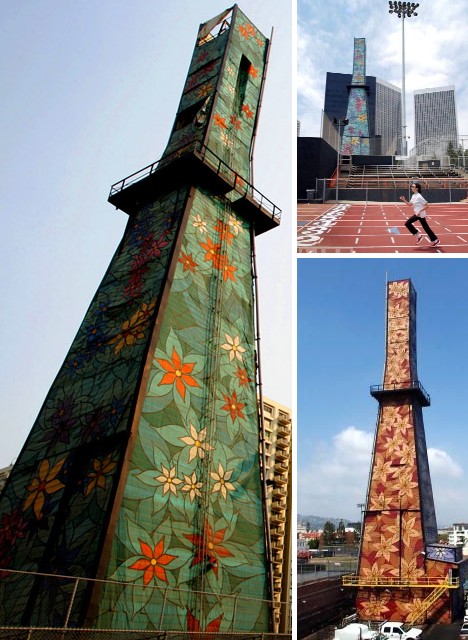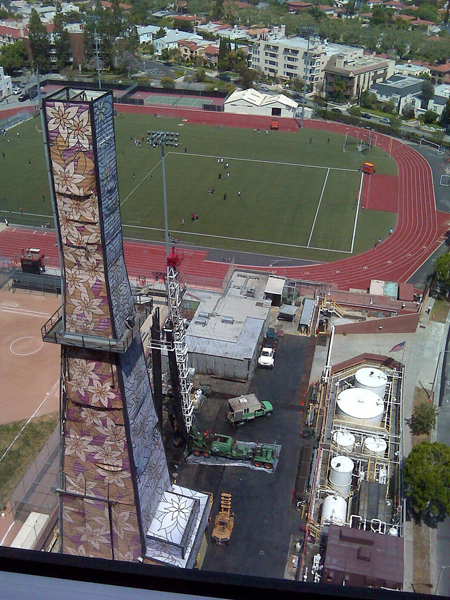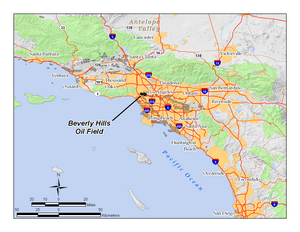Beverly Hills Oil Field
The Beverly Hills Oil Field (English Beverly Hills Oil Field ) is a large and currently active oil field beneath parts of the city of Beverly Hills and its neighboring city of Los Angeles in California. The oil field discovered in 1900, with a cumulative production volume of more than 150 million barrels of crude oil by size in California ranked 39th. It is unusual in that there is such a large, consistently used oil field in a metropolitan area. The overall activities of drilling, conveying and further transport for the 97 active within four big " rigs " - performed on Pico and Olympic Boulevard, where diagonally directed bores to the sources in the various oil-bearing formations - large, windowless building complexes extend directly under the million dollars expensive villas and commercial buildings in one of the wealthiest cities in the United States. The annual production of the oil field in 2006 amounted to 1.09 million barrels in 2007 to 966,000 barrels and 874,000 barrels in 2008. The remaining reserves are estimated by the California Department of Conservation on a lot of about eleven million barrels of crude oil. The three largest operators in 2009 were the independent oil companies Plains Exploration & Production, BreitBurn Energy and Venoco, Inc.
Location
Although it is uncommon for an oil field lies entirely within the city limits of a major city, this oil field is only one in the Los Angeles basin, which is now covered by dense residential and commercial development. The field is long and narrow. It is about six miles long and not even a kilometer wide. The long axis is approximately an east -west orientation, beginning at the intersection of Santa Monica Boulevard and Beverly Glen Avenue on the west, leads east on Pico Boulevard at La Cienega and Fairfax Avenue passing through the intersection with the Hauser Avenue. From north to south the oil field is narrow and stretched near its center from Monte Mar Drive in Los Angeles until about two blocks north of Olympic Boulevard in Beverly Hills. The total area comprises productive on the surface projected around 1200 acres ( about 480 hectares).
In most oil fields, the holes are made in the best location, right above the target area. However, this procedure is not possible within the confines of a densely populated city, so all the holes of four island-like buildings are made. These buildings are windowless, soundproof buildings - the impact on neighboring properties to keep as low as possible. The westernmost of these buildings containing oil wells, which are operated by Venoco, Inc., is located on the grounds of the Beverly Hills High School at the corner of Olympic Boulevard and Heath Avenue, directly south-west of the football field. There are also storage potion, several oil -water separation units, a pump house, a compressor room, and an office building for this Bohrkomplex.
Another device which is quite similar to the Beverly Hills High School, is operated by BreitBurn Energy north of Pico Boulevard, between Doheny Drive and Cardiff Avenue. The largest of these four rigs includes more than 50 active wells and operated by Plains Exploration & Production. It is also north of Pico Boulevard, however, between Genesee Avenue and Spaulding Avenue. One of the wells operated here also include those which are directed into the Salt Lake oil field to the northeast. Within the borders of the neighboring Cheviot Hills oil field, on the floor of the Hillcrest Country Club, about 150 meters south of the intersection of Pico Boulevard and Century Hill East Avenue is a fourth, smaller drilling center, which is operated by Hillcrest Beverly Oil Corp.. Here possesses several directly operated in that oil field drilling well 12 active sources that were drilled diagonally into the Beverly Hills Oil Field.
The operator of a fifth drilling center on the northern corner of the intersection of Avenue of the Stars with the Constellation Boulevard in Century City gave up this 1990. This facility was built in the 1950s on a former background piece of 20th Century Fox Studios. From the 1970s, the production decreased continuously and the last source was closed in 1989. The land use change and rising real estate prices contributed to the closure at.
The city council of Los Angeles is responsible for all permits and emissions of buildings in relation to the oil field.
Geology
The field is an anticlinal structure, in which the oil has been incorporated by a combination of structural and stratigraphic mechanisms. South of the oil field is the Brentwood - Las Cienegas Fault and on the west it ends near the Santa Monica fault complex. The least depth of the larger deposits economically recoverable oil ranges from about 1600 to 2100 m below sea level ( the average position of this area of the basin of Los Angeles is about 60 m above sea level).
The top producing unit was the first discovered oil-bearing layer, which became known as Wolf Skill Zone and within the so-called Repetto Sands, one originated in the Pliocene structure especially in the western part of the oil field. The oil in these sands is found mainly in compressed structures in which the oil is trapped in permeable layers of impermeable layers. Below this unit is separated by an unconformity, the more powerful Modelo Formation, which consists of several sands: D / M- sands above, the Hauser- sand, about 1400 m below sea level and the Ogden - sand, about 2200 m under the sea level. Below the Ogden - sand is a bulbous shale unit, which also belongs to the Modelo formation, however, is not oil-bearing. Both Ogden and Hauser- sand are very productive, in the D / M- sands are a few oil-bearing bubbles to find; these form an impenetrable blanket for the Hauser- sand elsewhere. The deepest oil well in the oil field is located in a part of the Ogden - sand in the eastern part of the field. It was discovered in 1967 and is located at a depth of around 3300 below sea level.
According to BreitBurn Energy, one of the larger producers in the eastern part of the field, 600 million barrels of crude oil originally present; so far 111 million barrels were promoted, so even 489 million barrels are left. However, the company did not specify how much of it can be used economically with current technology.
History, production and operation
Oil was discovered in the northern part of the basin of Los Angeles in 1893, not far from the center of the city. The expansion of the Los Angeles City Oil Field was rapid and in 1895 produced this oil field more than half of the pumped crude oil in California. The Bohrleute began to look for other oil fields in the basin, also to keep pace with the developed oil fields in Kern County step. In July 1900 drilled W. W. Orcutt in the Wolfskill zone of Repetto Sands, about 750 m below the surface and thus discovered the Beverly Hills oil field. While the oil was of a sufficiently good quality - it was thin, with a high API gravity ( 33-60 ), yet with only a small proportion of sulfur - but was the development of slow because this discovery was relatively small and other oil fields almost as soon grew in the Los Angeles basin, such as the operators were able to build rigs.
The eastern part of the oil field - usually just known as East Area - is the most productive. It is also the date last discovered the major oil fields in the Los Angeles Basin; it was not found until 1966. His greatest flow reached the field already rapidly, within two years, when in 1968 a capacity of 11.8 million was reported. 1988 bought BreitBurn Energy part of the Beverly Hills Oil Field, to apply modern exploration techniques and secondary recovery technologies to the depleting oil field after the previous operator to retreat began in favor of less regulated areas where less expensive technologies are available.
The operator of the oil field began in 1968 in various (now of BreitBurn Plains and operated ) pool of the East Area with the water injection. In this method, produced water is pumped into the oil-bearing layers so as to increase the pressure. Usually, drops this pressure, the more Röhöl encouraged, so that the flow always goes back further. By submitting Pitzen of water is counteracted. The use of this water is in an urban environment is also a convenient way to eliminate these industrial effluents, because the crude oil from the oil field managed to boiling water often exceeds the amount of oil production. In oil fields in isolated areas one uses sprawling pool of water, so that the excess water can evaporate. In a metropolitan area that is not possible, on the one hand for reasons of space, on the other hand, because higher standards apply in an urban environment in terms of environmental protection. So for 2008, the California Department of Conservation, Division of Oil, Gas, and Geothermal Resources ( DOGGR ) are for the oil field have a capacity of 882 953 barrels Röhöl and additional 8,732,941 barrels of water to. Of these, 7,280,887 barrels were pumped back into the oil-bearing layers.
Because many of the residents of the area have the mineral rights to their property, they are entitled to the payment of royalties for oil, which was sponsored by taking their land. 1975 received around 6200 people such payments.
The development of the oil field was not without controversy. The Bohrkomplex at the Beverly Hills High School in 2003 led to a series of court cases in which parents of students of the school brought an action button to adjust the operation of the plant. They believed, to notice an increase of cancers among those issues were exposed by the drilling. The plaintiffs claimed that a " cluster " of 280 cancers - especially Hodgkin's Lymphoma, Non -Hodgkin's lymphoma and thyroid cancer, recorded over a period of 30 years - of emissions of volatile organic compounds, including benzene and toluene by the rig went out. Samples that were taken by the South Coast Air Quality Management District ( AQMD ), revealed no unusual data and 2006 and 2007, the proceedings were dropped. University of Southern California Medical School, according to which one could not assume that they are caused by the influence of petroleum and its by-products due to the knowledge referred to in the complaints cancers.







.jpg)


